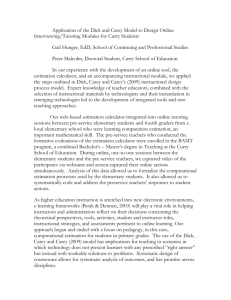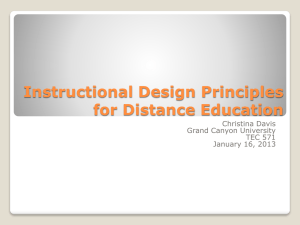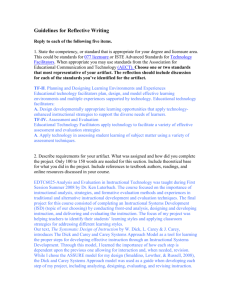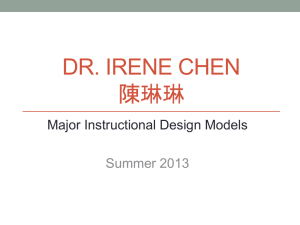The Dick and Carey Model
advertisement
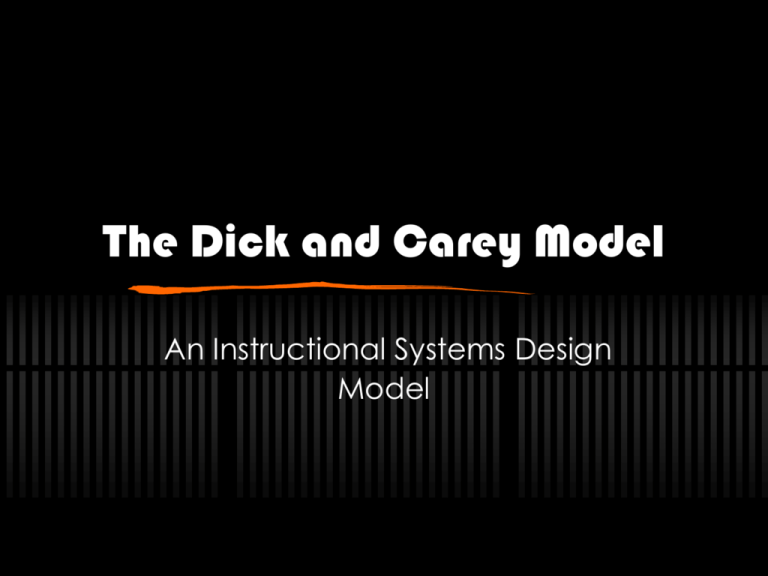
The Dick and Carey Model An Instructional Systems Design Model Who Are Dick & Carey? Walter Dick: Studied with Robert Gagne. Emeritus Professor at Florida State University. Lou Carey: Studied with Walter Dick and Robert Gagne. University of South Florida Professor and Interim Dean. Dick & Carey Model “Performance-oriented model, stressing the identification of skills students need to learn and the collection of data from students to revise instruction” Based on the reductionist perspective, which emphasizes breaking instruction down into smaller components. Focuses on the skills, knowledge, attitudes that need to be learned and provides the right learning conditions for the outcomes. “Based on the idea that there is a predictable and reliable link between a stimulus (instructional materials) and the response that it produces in a learner (learning of materials).” Dick & Carey, Past and Present First Edition, 1978: Very traditional ISD approach, with emphasis on behavioral theory and some cognitivist theories. Second Edition, 1996: Still traditional, reflects an attempt to incorporate changes in the field, such as shifts toward constructivism, growth in computers, etc. Dick & Carey Model Conduct Instructional analysis Revise Instruction Develop Assessment instruments Assess needs to Identify goals Write Performance Objectives Analyze learners And contexts Develop Instructional strategy Develop and Select Instructional materials Design and Conduct Formative Evaluation of instruction Design and Conduct Summative evaluation Shell Island Simulation Contexts for Dick & Carey Model seem to endless. Shell Island is a good example of how modify the traditional ISD approach with constructivist goals. Part of a reform project by Carolina Coastal Science project with a goal to create an online environment for primary and secondary students to engage in authentic scientific inquiry. Shell Island Dilemma Students investigate the fate of the Shell Island Resort through the resources available on NCS website. After considering the scientific, social, political issues, they engage in a debate over its future. QuickTime™ and a Cinepak decompressor are needed to see this picture. Shell Island D&C Model Determining Instructional Goals Determined out of a lack of good environmental science curricular and inquiry-based simulations in North Carolina secondary schools. Instructional goal is for learners to be able to identify the scientific, social, political, and moral issues that “different stakeholders must deal with in a current environmental science issue.” 1 Analyzing the Instructional Goal Students identify environmental and economic concerns of stakeholders. Students take a position for or against building a hard structure to protect the Shell Island Resort. Shell Island D&C Model Analyze Learners and Context Use technology skills and critical thinking skills to explore online resources and construct a logical argument for unresolved issue. Use decision-making skills to act on personal and social interests. 2 Write Performance Objectives Students will list the 3 strongest arguments for and against building a hard structure to protect Resort. Students will identify individuals for and against. Students will prepare statement for next course of action. Shell Island D&C Model Developing Assessment Instruments Students complete a “Position Statement Handout” designed to assess stated objectives for an in class debate. Students complete a “Student Record Sheet Assessment” at the conclusion of debate. 3 Developing Instructional Strategy Terminal Objectives: Design role-playing activity Select unresolved issue Collect background info Develop real-life scenario Identify roles of real people (stakeholders) Develop student roles Select Debate format with time limits Shell Island D&C Model Developing and Selecting Instruction Materials are developed in the context of “The Shell Island Dilemma” web site, with many resources for students Educator’s Guide is provided, recommending teaching strategies and assesments 4 Designing and Conducting Formative Evaluation Included a small group of primary and secondary school educators enrolled in a ET graduate course. They made recommendations to modify program Shell Island D&C Model Revising Instruction Upon recommendations by group: Specific descriptions of stakeholders were developed. “Student Record Sheet Assessment”’ was developed. Debate simulation was tested on 10th grade environmental science class. “Position Statement Handout” was created. 5 Conducting Summative Evalution Conducted by marine education specialist, a coastal geologist, a university professor with C&I expertise, and two secondary school environmental science teachers. No further recommendations were made. Dick & Carey Model Advantages Can be applied in almost any context. Can adjust well for changes in theory or technology. Has been around a long time. Disadvantages Learning is nonlinear. Presumes that learning is predictable and reliable. Does not allow for mistakes. References Carey, L. & Dick, W. (1996). The Systematic Design of Instruction. Longman; New York, NY. Bodzin, A.M. & Park, J.C. (1999). An Online Inquiry Instructional System for Environmental Issues. Meridian: 2(2). http://www.ncsu.edu/meridian/jul199/coastal/bodzinparkbio.html. Retrieved 09/25/07. Dempsey, J.V. & Reiser, R.A. (2007). Trends and Issues in Instructional Design and Technology. Pearson; Upper Saddle River, NJ. McGriff, S.J. (2001). ISD Knowledge Base/ Instructional Systems Design Models/ Dick & Carey. http://www.personal.psu.edu/faculty/s/j/sjm256/portfolio/kbase/IDD/dick &carey.html. Retrieved 09/25/07. Reiber, L. http://lreiber.myweb.uga.edu/edit6170/ppt/unitgoal_analysis.ppt. Retrieved 09/25/07.
